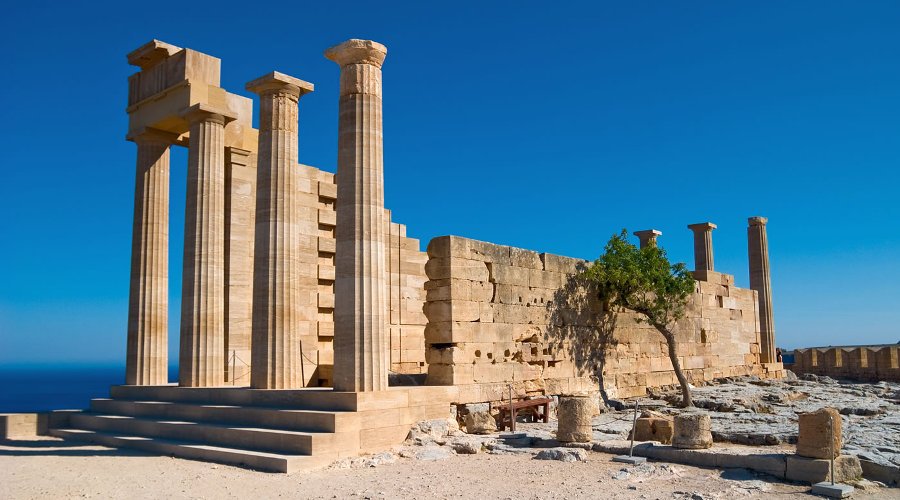8 h. tour (Private tour)
(transportation + guidance throughout + guided tour of Lindos + walking guided tour of the Old town of Rhodes + guided tour of the Archaeological museum of Rhodes + guided tour of the Palace of the Grand Masters + free time)
For those of you that have a full day at their disposal, this is the ideal tour to see all the highlights of the island. You will be be offered private transportation to the archaeological site of Lindos, enjoy a guided tour of Lindos, and then return back to Rhodes for a complete walking guided tour through the Old town of Rhodes.
Lindos was founded by the Dorians, led by the king Tlepolemus of Rhodes, who arrived in about the 10th century BC. It was one of six Dorian cities in the area known as the Dorian Hexapolis. The eastern location of Rhodes made it a natural meeting place between the Greeks and the Phoenicians, and by the 8th century Lindos was a major trading centre. Its importance declined after the foundation of the city of Rhodes in the late 5th century BC.
In classical times the acropolis of Lindos was dominated by the massive temple of Athena Lindia, which attained its final form in around 300 BC. In Hellenistic and Roman times the temple precinct grew as more buildings were added. In early medieval times these buildings fell into disuse, and in the 14th century they were partly overlaid by a massive fortress built on the acropolis by the Knights of St. John to defend the island against the Ottomans.
Above the modern town rises the acropolis of Lindos, a natural citadel which was fortified successively by the Greeks, the Romans, the Byzantines, the Knights of St John and the Ottomans. This makes the site difficult to excavate and interpret archaeologically. The acropolis offers spectacular views of the surrounding harbors and coastline.
On the acropolis of Lindos today parts of the following buildings may still be seen:
- The Doric Temple of Athena Lindia, dating from about 300 BC, built on the site of an earlier temple. Inside the temple is the table of offerings and the base of the cult statue of Athena.
- The Propylaea of the Sanctuary, also dating from the 4th century BC. A monumental staircase leads to a D-shaped stoa and a wall with five door openings.
- The Hellenistic stoa with lateral projecting wings, dating from about 200 BC. The stoa is 87 meters long and consisted of 42 columns.
- The well-known relief of a Rhodian trireme (warship) cut into the rock at the foot of the steps leading to the acropolis.
- On the bow stood a statue of General Hagesander, the work of the sculptor Pythokritos. The relief dates from about 180 BC.
- The Hellenistic staircase (2nd century BC) leading to the main archaeological area of the acropolis.
- Remains of a Roman temple, possibly dedicated to the Emperor Diocletian and dating from about 300 AD.
- The Acropolis is surrounded by a Hellenistic wall contemporary with the Propylaea and the stairway leading to the entrance to the site. A Roman inscription says that the wall and square towers were repaired at the expense of P Aelius Hagetor, the priest of Athena in the 2nd century AD.
- The Castle of the Knights of St John, built some time before 1317 on the foundations of older Byzantine fortifications. The walls and towers follow the natural conformation of the cliff. A pentagonal tower on the south side commanded the harbor, the settlement and the road from the south of the island. There was a large round tower on the east facing the sea and two more, one round and the other on a corner, on the northeast side of the enceinte. Today one of the towers at the southwest corner and one to the west survive.
- The Greek Orthodox Church of St John, dating from the 13th or 14th century and built on the ruins of a previous church, which may have been built as early as the 6th century.
After the end of the guided tour of Lindos, you will board your private vehicle and return back to Rhodes and start your complete walking tour of the Old town.
Entering the gateways you will walk parallel to the big fortified wall, with your guide stopping you in some points of interest for further explanations as well as for panoramic views. On the way you will walk through the area of the Agora and the Collachium, where the Knights of St. John of Jerusalem lived and worked, building a stronghold of Christendom in the Eastern Mediterranean. The building of the hospital of the knights of St. John is one of the most impressive and old buildings remaining in the Old town, and houses today the archaeological museum of Rhodes, which is worth for a short visit. Among other things you will see ancient Greek statues, including the Aphrodite of Rhodes, made of parian marble, urns and pots, funerary plaques etc.
Remaining remarkably intact, the Old Town is home to the churches, marble coats of arms of the Knights, cannonballs and the inns of the Knights. Entering the famous Knight Street you will start ascending to the level where the very impressive restored Palace of the Grand Masters lies and you will enter it for your guided tour and detailed explanation of the different historic periods of the island and the palace. There among other things you will see very impressive mosaic floors, several rooms that served the everyday needs of the palace, as well as one of the most famous and well done copies remaining of the complex of the statues of Laotoon, a famous ancient statue which is today kept in the Vatican museum.
At the end of the tour you will be free to use the remaining time you have on the island, walking around, taking pictures and further exploring its magnificent areas on your own.







Leave your comments
Post your review